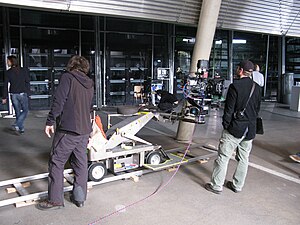Dolly (camera car)
A dolly ( English for transport trolley) is a trolley with which smooth, jolt-free camera movements can be implemented even on uneven surfaces. All dollies have three or four wheels and the option of attaching a camera. Otherwise there are different technical approaches such as the camera slider .
The western dolly
This is the simplest variant, it consists of four tires that carry a platform on which a Euromount is mounted. The steering mode can be adjusted depending on the model so that you can move two or four wheels. So the dolly can be pulled or pushed and moved like a car . The camera is attached to the Euromount at the required height using so-called bazookas (risers). The cameraman and his assistant are usually on the platform.
This dolly is particularly suitable for driving on even ground with only slight bumps and is valued for its simplicity. However, western dolls are rarely used.
The hydraulic dolly
This variant is mainly used in North American productions. It can be used with different tires, both on and without rails, and is characterized by a scissor-like hydraulic lifting system. The Dolly Grip (German: Kamerabühnenmann ) operates this by means of a valve. The wheels can be steered in various combinations: two-wheel steering, four-wheel steering - all wheels point in the same direction - and four-wheel steering - front and rear wheels steer in opposite directions. The advantages (compared to the lifting column dolly) are the enormous speed of the lifting device, the independence from the power supply and the maximum height difference. Scissor dollys are usually from Chapman-Leonard Studio Equipment or JL Fisher . Its bulkiness and weight are disadvantageous.
The lifting column dolly
This is the most common variant in Europe. It has a square base and an electric telescopic lifting column in the middle. The wheels are individually fixed, steerable and freely switchable. It can also be used on rails or on level ground. In contrast to the scissor dolly, a seat for the cameraman can be attached to the column so that he can move along with changes in height. The electrical control enables precise programming of vertical journeys.
The lower maximum stroke compared to the scissor dolly can be compensated for by a so-called jib arm , a kind of mini camera crane that is set up on the dolly.
The mini dolly
This variant, known as the skater dolly , is based on three skate wheels, is extremely flat and does not require a complex rail system. As a small, transportable and universally usable dolly, it enables camera movements even in extremely restricted spaces. Since you can do not only very low, but also precise circular tracking shots with this dolly, e.g. B. around an object, it is often used in the advertising film sector for product shots.
The mini dolly was invented by the director and cameraman Sebastian Kramer, and in cooperation with the film equipment manufacturer P + S Technik it was developed and patented until it was ready for series production. The mini dolly is manufactured and sold in two differently complex variants: as a Skater Mini and as a Skater Junior , which is much cheaper. Inventors and manufacturers were responsible for the skater product family, which u. a. includes various structures and a motorization, awarded the so-called Technology Oscar of the Academy of Motion Picture Arts and Sciences and the Emmy Engineering Plaque.
History of the dollys
At the beginning of film history almost exclusively “theater-like” recordings were made. Long or medium long shots alternated, cuts were rare, all camera settings were static. The first tracking shot was used by the Lumière brothers , where they simply placed the cameraman and camera on a railroad car. In 1896, Alexandre Promio placed the camera on a vaporetto for the documentary Panorama du Grand Canal vu d'un bateau .
The first dolly that allowed vertical tracking shots was the Chapman , the most famous scissor dolly. Originally it was a development by the US Air Force , which in World War II used a lifting trolley to attach the bombs to the bottom of the wings of fighter planes. At first these dollys were taken over one-to-one, only later they were further developed especially for film work. The first electro-mechanical dolly was the Super Panther , a lifting column dolly that won the technical Oscar Scientific and Engineering Award in 1990.
The European dollys went their own way from the start by relying on the lifting column, initially - also hydraulically - with a foot pump. Due to their lighter and more compact construction, they were better suited for films that were mostly shot on original locations than the large and heavy American ones.
Today the tracking shot is a central part of almost every film or television production, often not even consciously perceived by the audience, as it only makes shots appear "more natural". A current development is motion control , which means that camera and dolly movements are completely programmed and can be repeated exactly in the same way, which makes effects such as morphing in the camera movement possible.
See also
- Steadicam
- Dolly zoom (film effect with a tracking shot)
Web links
Individual evidence
- ↑ Oscar for the robot Panther , Der Spiegel , edition 15/1990


